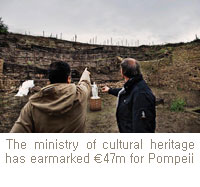 Controversy over Pompeii funding
Controversy over Pompeii fundingPoliticians have allocated €8.2m for an archaeological survey that already exists
Politicians and archaeological experts are at loggerheads over the funding of the restoration and conservation of Pompeii ten months after the House of Gladiators collapsed. The house, which still lies in ruins, is awaiting the arrival of a task force of technicians and archaeologists, who have yet to be recruited. According to culture minister Giancarlo Galan, Unesco has threatened to strip the ancient site of its World Heritage status if immediate, decisive action is not taken.
Funding for the €150m needed for archaeological excavations in Italy is, in principle, coming from the European Union, although the Italian government has yet to submit a formal application for the funds. Despite this, the governing council of the ministry of cultural heritage has already earmarked €47m for the restoration and conservation of Pompeii, with €8.2m allocated for inspections and three-dimensional surveys. However, seemingly without the ministry’s knowledge, a three-dimensional study of the site has just been completed by experts from four Campania universities, in co-operation with the Sorbonne, the Barcelona School of Architecture, the Fulbright Commission and the Italian National Commission of Unesco.
The three-year study, entitled “Pompeii, Fabbrica della Conoscenza” (“Pompeii, the Knowledge Factory”), was carried out using the most advanced technology, according to Carmine Gambardella, dean of the faculty of architecture at the Second University of Naples (Aversa).
“After the collapse of the House of Gladiators, we flew over the excavations with the Guardia di Finanza, using an infrared thermal sensor to locate at-risk areas and so redraw a map of the site,” said Gambardella.
The ministry-approved survey, therefore, amounts to a costly “repeat performance”. The cultural affairs branch of the Italian Labour Union has reported the matter to the public prosecutors of Torre Annunziata, Naples and Rome, calling for transparency in the awarding of such public contracts.
The private sector is also taking a keen interest in Pompeii. The Naples Industrialists’ Union (NIU) has presented a three-stage strategy for the development of the archaeological site. The first aim is to promote the Pompeii “brand” and to attract global sponsors. The second is to surround the site with a ring of hotels, shops, information points, parks and other facilities, to be connected with local and national transport links. The third aim is to ensure co-ordination with the local and regional authorities.
According to Antonio Graziano, the chairman of the NIU, a consortium of 2,500 French companies is interested. The plan is opposed by art historian and archaeologist Salvatore Settis. “It would be like letting the Colosseum fall down then building a series of facilities around it,” he said.
By Edek Osser | From issue 227, September 2011
Published online 14 Sep 11 (News)
 Controversy over Pompeii funding
Controversy over Pompeii funding